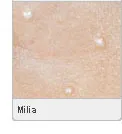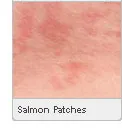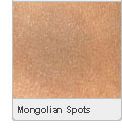How to Get Rid of Red Bumps on Baby Face
Your Newborn's Skin and Rashes
A newborn'south skin is prone to rashes of all sorts. Fortunately, near of these rashes are harmless and get abroad on their own.
Common Rashes in Newborns
-
 Pink pimples ('neonatal acne') are sometimes thought to be caused by exposure in the womb to maternal hormones. No treatment is needed, merely time. They can terminal for weeks or even months on a baby'due south skin.
Pink pimples ('neonatal acne') are sometimes thought to be caused by exposure in the womb to maternal hormones. No treatment is needed, merely time. They can terminal for weeks or even months on a baby'due south skin. - Erythema toxicum is another common newborn rash. It looks like red blotches with ill-defined borders that are slightly raised, and may accept a pocket-size white or yellow dot in the centre. Its cause is unknown, and it resolves without treatment after a few days or weeks.
- Dry out, peeling skin tin can be seen in near all normal babies, simply is particularly noticeable in babies built-in a little late. The underlying skin is perfectly normal, soft, and moist.
-
 Little white bumps on the nose and face (milia) are caused by blocked oil glands. When a baby's oil glands enlarge and open up up in a few days or weeks, the white bumps disappear.
Little white bumps on the nose and face (milia) are caused by blocked oil glands. When a baby's oil glands enlarge and open up up in a few days or weeks, the white bumps disappear. - Salmon patches (called a ''stork seize with teeth'' at the dorsum of the neck or an ''angel's osculation''
 between the optics) are uncomplicated nests of blood vessels (probably caused by maternal hormones) that fade on their own later on a few weeks or months. Occasionally, stork bites never go away.
between the optics) are uncomplicated nests of blood vessels (probably caused by maternal hormones) that fade on their own later on a few weeks or months. Occasionally, stork bites never go away. - Jaundice is a yellow coloration on baby's skin and eyes. It is caused by an excess of bilirubin (a breakup production of red blood cells). If the bilirubin level becomes sufficiently high, blue or white lights may exist focused on the babe's skin to lower the level, because excess bilirubin can sometimes pose a health hazard.
-
 Congenital Melanocytosis, previously called Mongolian spots,are very common in whatever part of the trunk of dark-skinned babies. They are flat, gray-blue in color (almost looking like a bruise), and can be small or large. They are caused by some pigment that didn't make it to the elevation layer when baby's skin was existence formed. They are harmless and unremarkably fade away by school historic period.
Congenital Melanocytosis, previously called Mongolian spots,are very common in whatever part of the trunk of dark-skinned babies. They are flat, gray-blue in color (almost looking like a bruise), and can be small or large. They are caused by some pigment that didn't make it to the elevation layer when baby's skin was existence formed. They are harmless and unremarkably fade away by school historic period.
New rashes may announced in babies after a few days, weeks, or even months.
Continued
Mutual Rashes in the Start Few Months of a Babe'south Life
- Cradle cap(seborrhea) often shows upward at ane-ii months of historic period. Greasy, yellowish crusts appear on the scalp and may include a ruby-red, irritating rash on the face, behind the ears, on the cervix, and even in the armpits. Your doctor volition tell you how to best treat this common status, depending on your infant's symptoms.
- Eczema is ruby, itchy patches on the pare, frequently seen on the baby's breast, artillery, legs, face, elbows, and backside the knees. It is caused past dry, sensitive skin, and sometimes allergies (although it can be difficult at this age to know what the trigger might exist). Your doctor can decide if the rash looks like eczema and prescribe the appropriate treatment. In general, treatment consists of:
- Using a very gentle soap
- Using a gentle detergent and no fabric softener in baby's laundry
- Using skin moisturizers
- Applying a steroid cream (similar hydrocortisone or even a stronger one) if the eczema won't go away
- Prickly heat looks similar small red bumps, generally on areas of your baby's trunk that tend to overheat and sweat, similar the neck, diaper area, and armpits. The treatment is to try to keep the area dry and avoid overheating by dressing them in loose-plumbing equipment clothing.
- A fungal infection(candidiasis) can testify upward in unlike ways on your baby. On the tongue, it is called thrush and looks similar dried milk, which, unlike milk, cannot be scraped off. In the diaper area, candidiasis looks like an intense red rash, often with smaller bumps around the edges. A fungal infection loves moist, nighttime areas, so you lot'll find redness due to it in the creases of the thighs. Candidiasis is treated with antifungal oral gel or liquid medicine (for oral thrush) or antifungal cream (for the diaper area), or both.
Tips for Concerned Parents
In the first few months of a baby's life, any rash associated with other symptoms (such every bit fever, poor feeding, languor, or cough) needs to be evaluated by a md as shortly as possible.
Connected
When to Worry About Baby's Rash
While most rashes are not serious, a few need very shut attending:
- Fluid-filled blisters (specially ones with opaque, yellow fluid) can indicate a serious infection, like a bacterial infection or canker.
- Small-scale red or purplish dots over the body (''petechiae'') can be acquired by a viral infection or a potentially very serious bacterial infection. These will not lighten with pressure. Whatever baby with possible petechiae should be evaluated past a medico immediately.
Pagination
Source: https://www.webmd.com/parenting/baby/baby-skin-rashes
0 Response to "How to Get Rid of Red Bumps on Baby Face"
Post a Comment